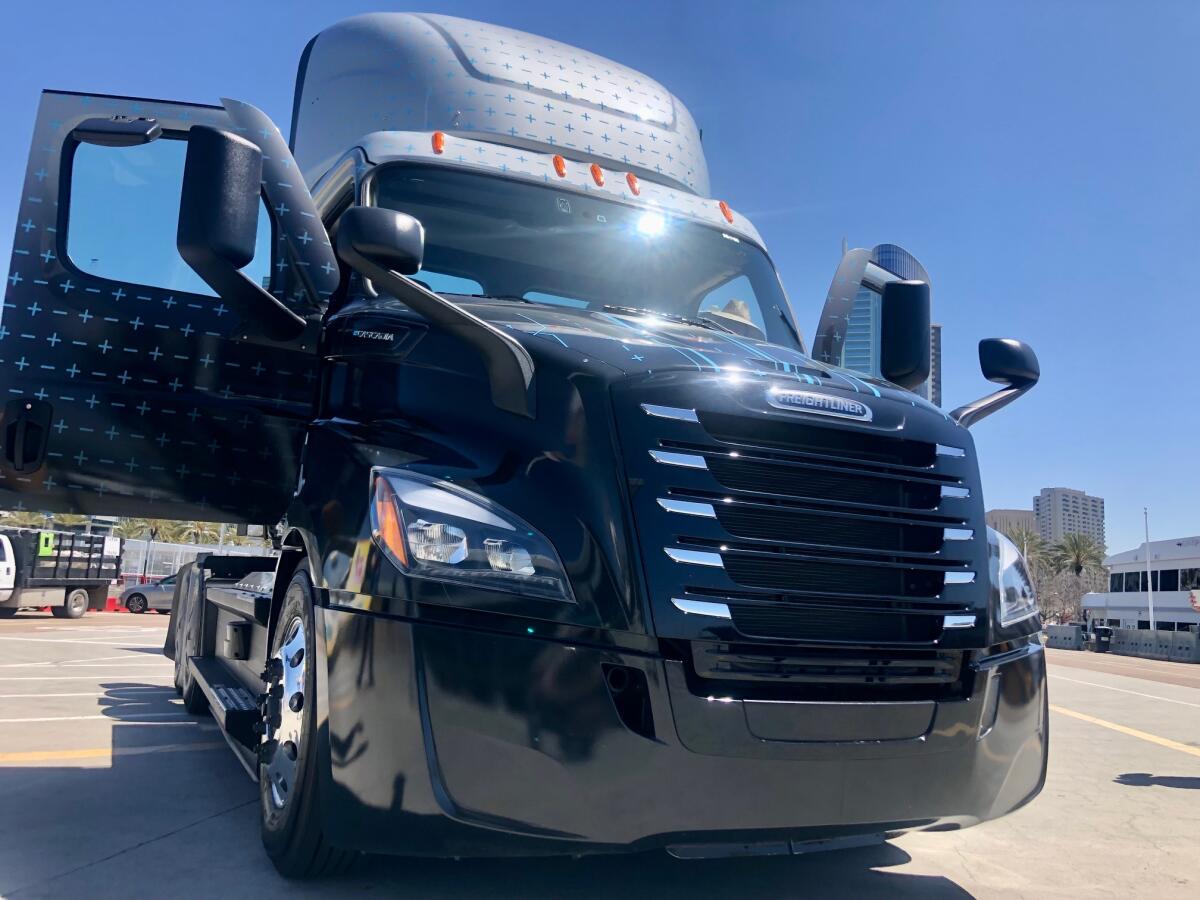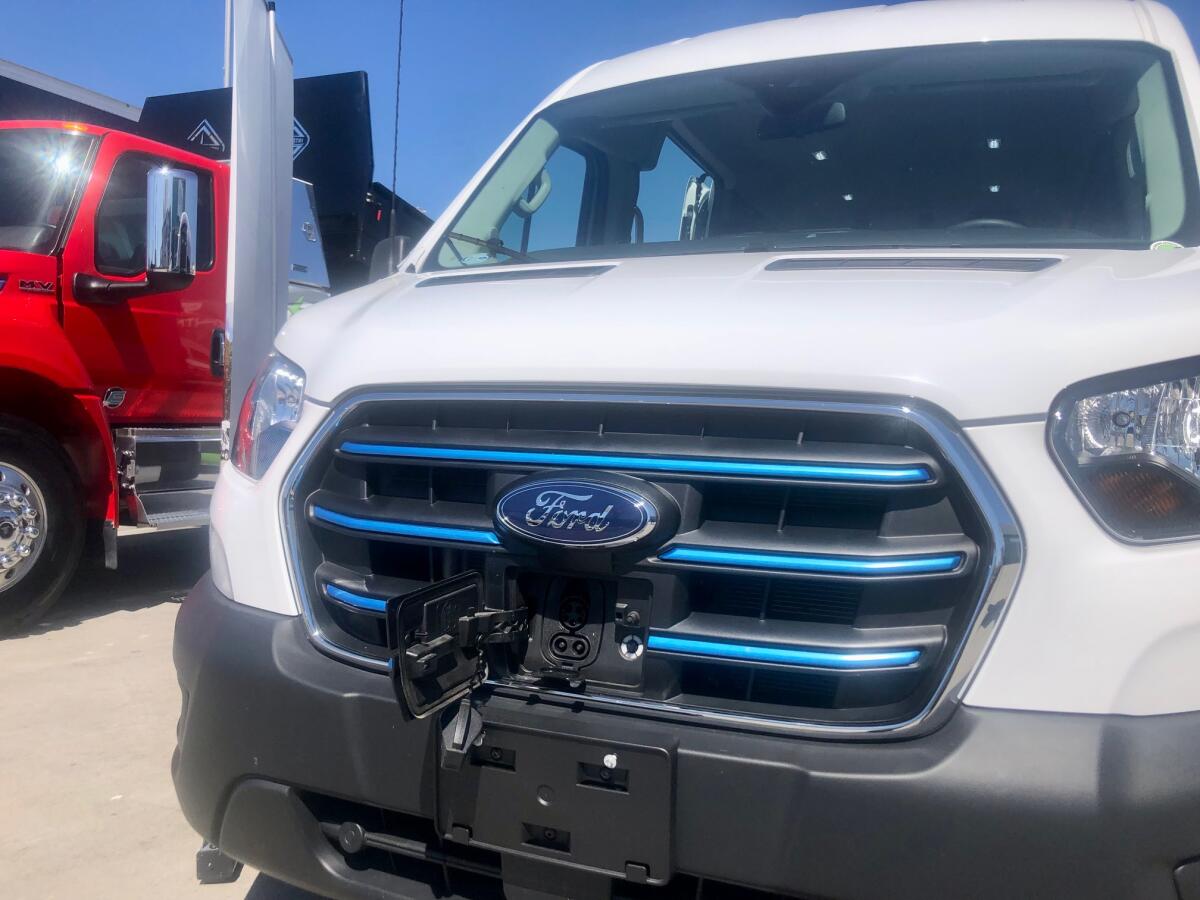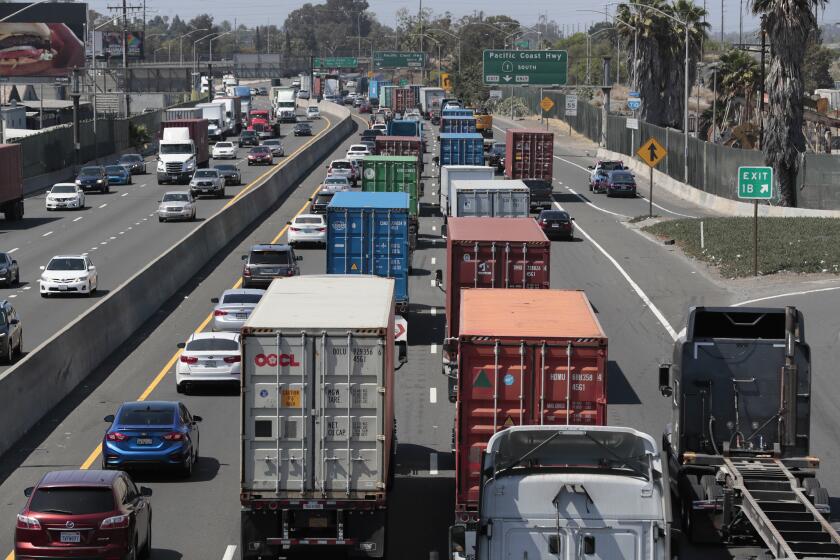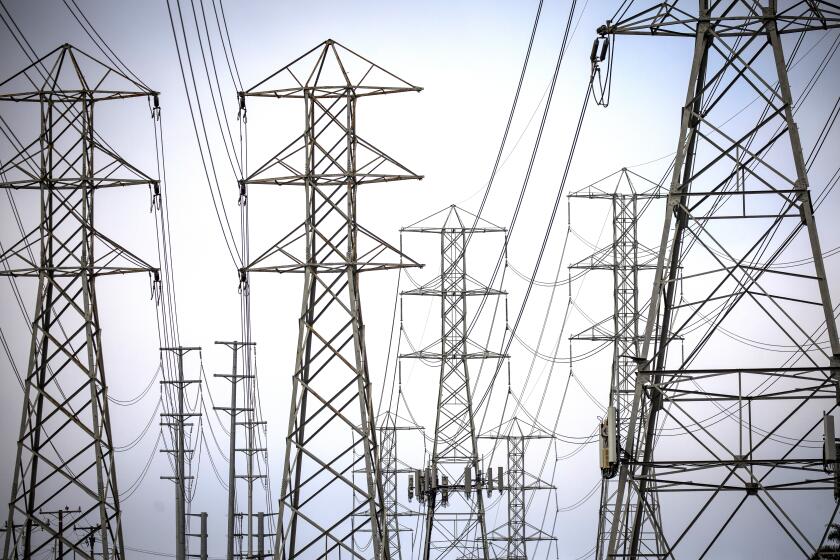California’s big plans to electrify big rigs: Zero-emissions mandates gain momentum

When people think of electric vehicles, they typically think of passenger cars, not commercial trucks or vans. But the volume of medium- and heavy-duty EVs is growing, and recent decisions by federal and California regulators are sure to increase their numbers.
“I would say roughly 30% to 40% of our business this year will be battery electric,” said Andrew Freer, commercial vehicle sales manager for Creative Bus Sales, who on Thursday showed off the Ford E-Transit, an all-electric van, at San Diego’s annual EV Fleet Day.
A couple of years ago, Freer said, just 5% of his company’s business was in the EV space. “We’re making a big push with this now,” he said.
So are the state of California and the Biden administration.
While many are familiar with Gov. Gavin Newsom’s executive order that bans the sale of new gasoline-powered passenger cars by 2035, the state also has created mandates to clean up the fleet of big rigs rumbling along the Golden State’s streets and freeways.
The U.S. Environmental Protection Agency is clearing the way for California rules that will phase out the sale of diesel-powered trucks.
The White House cleared the way March 31 for the Environmental Protection Agency to allow California to impose strict zero-emissions requirements on heavy-duty vehicles sold in the state. The state needed approval from the White House because the standards exceed EPA requirements.
EPA approved two Clean Air Act waivers for California, including the Advanced Clean Trucks rule, which requires all medium- and heavy-duty vehicles to emit zero emissions by 2045, where feasible. By 2035, truck manufacturers must increase sales of new zero-emission Class 2b-3 trucks to 55%, Class 4-8 trucks to 75% and 40% for new semi-tractors.
The new standards will start to increase next year, and Massachusetts, New Jersey, New York, Oregon, Washington and Vermont are expected to follow suit. Combined with California, those states represent about 22% of the national truck market.

And later this month, the California Air Resources Board is expected to pass a similar set of rules for fleet owners, mandating that an increasing number of purchases of new commercial trucks, vans, buses and rigs be zero-emissions. If passed, minimum 10% quotas will begin as early as 2025 and incrementally increase to 100% as early as 2035.
“There’s no question that momentum is accelerating rapidly in the commercial electric vehicle market,” said Lawren Markle, senior manager at GNA, a Santa Monica clean transportation and energy consultancy. “We think this is a year where there will be a tipping point.”
For the record:
12:45 p.m. April 10, 2023An earlier version of this article said the Volvo VNR-E 300 electric truck weights 82,000 pounds. The truck can haul up to 82,000 pounds.
Nearly 20 commercial EVs were on display on Broadway Pier in San Diego, including the Volvo VNR-E 300, a Class 8 behemoth that can haul 82,000 pounds and costs “around $450,000,” said Melanie Des Laurier, salesperson for TEC Equipment, a truck and trailer dealership in La Mirada.
The state needs to invest billions of dollars in new electric lines to meet its climate change goals.
By comparison, diesel trucks of that size cost about $180,000 to $200,000. “But there’s lots of grants out there to help you get into one,” Des Laurier said.
Jason Chambers, regional sales manager for Workhorse, a company that manufactures electric-only commercial vehicles, displayed the W4 CC model, a Class 4 work truck with variable cargo space. Fully loaded with drawers and cabinets that fold out and a ladder rack for tools and equipment, the $215,000 EV is targeted at electric companies and municipal fleets for users such as water and parks and recreation departments.
Reaching the 100% target “is doable, especially for Workhorse,” Chambers said. “We have the manufacturing facility up and running [in Indiana]. We have vehicles available today, on the ground and ready to go.”

The new rules have not drawn cheers from everyone.
The trucking industry’s biggest trade group blasted the EPA decision.
“By granting California’s waiver for its so-called ‘advanced clean trucks’ rule, the EPA is handing over the keys as a national regulator,” American Trucking Assn. Chief Executuve Chris Spear said. “This isn’t the United States of California, and in order to mollify a never satisfied fringe environmental lobby by allowing the state to proceed with these technologically infeasible rules on unworkable and unrealistic timelines, the EPA is sowing the ground for a future supply chain crisis.”
Although nearly 19% of cars sold in California last year were zero-emission vehicles, fewer than 2% of all heavy-duty trucks were electric, according to the Commercial Carrier Journal, a trucking industry publication.
“With all of these added costs into the transportation and distribution sector, whether it’s a small retail shop or a Walmart or Target, it’s going to cost more to ship goods in California,” said Wayne Winegarden, a senior fellow at the Pacific Research Institute, which advocates for free-market solutions to policy issues. “If it costs more to ship goods and if everybody has those costs, it’s very likely that those costs will be shifted onto consumers.”
The California’s Air Resources Board, who have been mandating emission standards for decades, recently voted to stop selling new gas cars in the state by 2035. But in this political climate, can California continue to lead the way?
The day the waivers were issued, Newsom called them “a big deal for climate action” and said California is “leading the charge to get dirty trucks and buses — the most polluting vehicles — off our streets, and other states and countries are lining up to follow our lead around the world.”
As for concerns about feasibility and costs, Air Resources Board spokesman Alberto Larios said Newsom and the state Legislature have made $5 billion available to make the transition to cleaner trucks and buses, which includes incentives for fleet owners.
“Manufacturers are making major investments today to increase production of needed materials for zero-emission vehicles and develop domestic supply chains,” Larios said in an email.
Standing in front of the Class 8 Freightliner eCascadia semi that goes 230 miles on a full charge, Alexander Voets of the Velocity Vehicle Group in Whittier said the best use of electric big rigs is for shorter, regional deliveries — not for long-haul trips of, say, 500 miles, because the electric vehicle charging system is not yet sufficiently built out.
“This would usually be a vehicle that goes about 200 miles or so in a day in a typical duty cycle — think about your dedicated and repeatable routes,” Voets said. “That’s the prime application for battery electric trucks at the moment.”
Will the zero-emission transition for big commercial vehicles pan out?
“I think it’s going to work, it’s just a question of time,” Voets said. “It may not work as fast as people expect but two things need to happen. ... One thing is faster charging speeds. Right now it takes multiple hours to charge them. We need to get to under an hour. Then, we need public charging infrastructure that takes out all the upfront headaches out of the fleets and essentially provides electric gas stations” up and down roads and highways.
The Air Resources Board’s decision on its draft Advanced Clean Fleets rule is scheduled for April 27 or 28.










